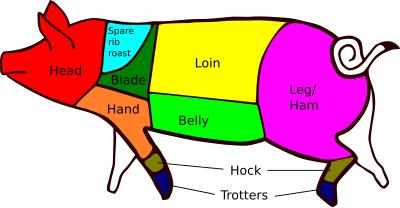Cut of pork


Thecuts of porkare the different parts of thepigwhich are consumed as food by humans. The terminology and extent of each cut varies from country to country. There are between four and sixprimal cuts,which are the large parts in which the pig is first cut: the shoulder (blade and picnic), loin, belly (spare ribs and side) and leg.[1][2]These are often sold wholesale, as are other parts of the pig with less meat, such as the head, feet and tail. Retail cuts are the specific cuts which are used to obtain different kinds of meat, such astenderloinandham.There are at least 25 Iberian pork cuts, includingjamón.[3]
Cuts
[edit]Head
[edit]The head of the pig can be used to makebrawn,stocks, and soups. After boiling, the ears can be fried[4]or baked and eaten separately. The cheeks can be cured and smoked to makejowls,known ascarrilladaorcarrilejain Spanish-speaking countries. The face ofIberian pigsis known aspestorejoorcareta,and it includes the ears and snout (morro).[3]The lower parts of the head are the neck (papada) and theamygdalae(castañetas).[3]In thePhilippines,the pig's face (the jowls, snout, and ears) is also a distinct cut calledmaskara('mask').[5]The tongue, which weighs around 250 grams, is also eaten.[3]
Blade shoulder
[edit]
Above the front limbs and behind the head is the shoulder blade.[2]It can be boned out and rolled up as a roasting joint, or cured as "collar bacon". Also known as spare rib roast and joint, it is not to be confused with the rack of spare ribs from the front belly.Pork butt,despite its name, is from the upper part of the shoulder. TheBoston butt,or Boston-style shoulder cut, comes from this area and may contain the shoulder blade. Mexicancarnitas[1]and Iberianaguja[3]are also sourced from this part. Between theagujaand thelomo(loin) is thepresa,which is considered the finest cut of Iberian pork.[3]Twowell-marbled600 g cuts ofpresaare obtained from each Iberian pig.[3]Two smaller 100 g cuts known asplumaare obtained from beneath thepresa.[3]The Italiancoppais obtained from the top of the shoulder.
Shoulder arm picnic
[edit]The arm shoulder[2]can be curedon the boneto make a ham-like product ( "picnic ham") or be used in sausages. The hands (orpaletasin Ibérico pigs) refer to the front legs, as opposed to the hind legs, which are hams orjamones.[3]Between thepaletaand the belly is a 150-200 g cut known assecretowhich is very popular in Spain.[3]
Loin
[edit]
Theloin[6]can be cured to makeback baconor Canadian-style bacon. The loin and belly can be cured together to make a side of bacon. The loin can also be divided up into roasts (blade loin roasts, centre loin roasts, and sirloin roasts come from the front, centre, or rear of the loin), back ribs (also called baby back ribs, or riblets), pork cutlets, andpork chops(chuletas). A pork loin crown roast is arranged into a circle, either boneless or with rib bones protruding upward as points in a crown.Pork tenderloin,removed from the loin, should be practically free of fat. It is known aslomoin Spain, where it is most often prepared as afileteor cured as acaña de lomo.[3]This high-quality meat shows a very ordered arrangement of muscle cells that can causelight diffractionandstructural coloration.[7]
Fatback
[edit]Thesubcutaneous fatand skin on the back (fatback) are used to makepork rinds,a variety of cured "meats",lardons,andlard.Britishpork scratchingsand Hispanicchicharronesare also prepared from this cut.
Spare ribs
[edit]Spare ribsare taken from the pig'sribsand the meat surrounding the bones. St. Louis–style spareribs have the sternum, cartilage and skirt meat removed. The termabanicois used to refer to the ribs of Iberian pigs. It is very fatty and commonly barbecued.[3]
Belly or side
[edit]

The belly, although a fattier meat, can be used for steaks or diced as stir-fry meat. Pork belly may be rolled for roasting or cut forstreaky bacon.It is the source of Italianpancettaand Spanishpanceta.[3]
Legs or hams
[edit]
Although any cut of pork can be cured, technically speaking only the back leg is entitled to be called a ham. Legs and shoulders, when used fresh, are usually cut bone-in forroasting,or leg steaks can be cut from the bone. Three common cuts of the leg include the rump (upper portion), centre, and shank (lower portion). The ham ofIberian pigsis known asjamón.
Ham hock
[edit]The joint between the feet and the leg, known asham hockor pork knuckles, is cooked in many European countries, including Austria (stelze), Czech Republic (koleno), Germany (eisbeinandschweinshaxe), Hungary (csülök), Poland (golonka), Spain (codillo), Sweden (Fläsklägg) and Switzerland (wädli).
Trotters
[edit]Both the front and hindtrotterscan be cooked and eaten. They are colloquially known as "pigs feet" in the Southern United States[8]and asmanitas de cerdoin Spanish-speaking regions.[3]
Chitterlings
[edit]The intestines (chitterlings) and other internal organs (offal) are often boiled orstewed.Thetesticles(criadillas) are also eaten.
Tail
[edit]The tail has very little meat as it is mostly composed of connective tissue. It can be roasted or fried, which makes the skin crisp and the bone soft. It has a strong flavour.[8]Leonesebotillois made of chopped tail, ribs and bones, which are seasoned, stuffed in thececumand smoked.
See also
[edit]References
[edit]- ^abEditors of Cook's Illustrated Magazine (2014).The Cook's Illustrated Meat Book.America's Test Kitchen.ISBN9781940352145.
{{cite book}}:|last1=has generic name (help) - ^abcCattleman's Beef Board & National Cattlemen's Beef Association.Uniform Retail Meat Identity StandardsArchived2009-03-27 at theWayback Machine.Retrieved 11 July 2007.
- ^abcdefghijklmnCarrizosa, Pilar (2016).Jamón, Jamón: Secretos, rutas y recetas(in Spanish). LID Editorial. pp. 75–78.ISBN9788483568774.
- ^"Fried Pig Ears with Hot Sauce".Cooking Channel.Archivedfrom the original on 2017-04-05.Retrieved2017-04-30.
- ^Simpas, Jica."Pepper's English-Filipino Cheat Sheet: Common Pork Cuts".Pepper.ph.Retrieved7 February2023.
- ^"What Food Each Part of a Pig Makes (and their cuts)".Village Bakery.Village Bakery. 2017-10-02.Archivedfrom the original on 3 December 2017.Retrieved27 October2017.
- ^Martinez-Hurtado, J L (November 2013)."Iridescence in Meat Caused by Surface Gratings".Foods.2(4): 499–506.doi:10.3390/foods2040499.PMC5302279.PMID28239133.
- ^abHugh Fearnley Wittingstall. "The River cottage cookbook". Harper Collins.
